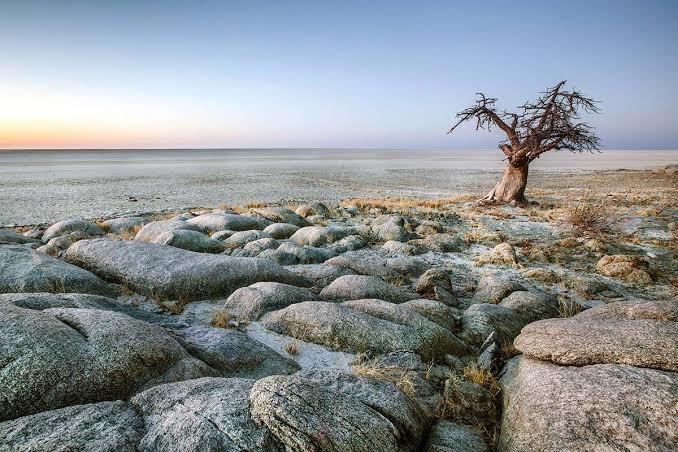Modern Human’s Homeland Is an Ancient Wetland in South Africa, Says Study

Abundance of evidence now exist which show that anatomically modern humans emerged in Africa over 2 lakhs years ago. The species thrived there for 70 thousand years before migrating out. However, the exact location where the emergence of modern humans took place has always been an issue of contention. Although the oldest skeletal remains suggest that the origin should be eastern Africa, there are other findings which hint towards southern Africa being the home to the contemporary populations of humans that represent the earliest branch of human genetic origin.
A new study published in the journal Nature confirmed that the origin of modern human lies in the southern Africa. The authors of the study suggest that Africa’s climatic changes triggered the eventual human exploration which initiated the development of human’s genetic, ethnic and cultural diversity.
The research, based upon DNA analysis, revealed that the earliest footsteps that humanity took were at a prehistoric wetland called Makgadikgadi-Okavango, located south of the great Zambezi river. It covers parts of modern-day Botswana, Namibia and Zimbabwe. Now, this area is a dusty, dry land and scattered salt pan. Modern humans thrived here some 2 lakh years back and for approximately 70 thousand years before they started exploring the rest of Africa and eventually the entire world.
Professor Vanessa Hayes of Garvan Institute of Medical research and University of Sydney and the lead author of the study said, “It has been clear for some time that anatomically modern humans appeared in Africa roughly 200 thousand years ago. What has been long debated is the exact location of this emergence and subsequent dispersal of our earliest ancestors. Mitochondrial DNA acts like a time capsule of our ancestral mothers, accumulating changes slowly over generations. Comparing the complete DNA code, or mitogenome, from different individuals provides information on how closely they are related.”
In their research, the team collected blood samples from the inhabitants of Namibia and South Africa. The aim was to establish a comprehensive catalogue that comprises modern human’s earliest mitogens from the L0 lineage. The L0 lineage is the DNA sequence that can only be found only in the mitochondria, the tiny sub-cellular compartment providing energy to a cell. Moreover, the DNA in the mitochondria is maternal in nature, that is, this DNA is passed on to the progeny by the mother only. This analysis of the mitogenome from the blood samples collected, allowed the scientists to uncover rare and new L0 sub-branches.
Describing their approach, the first author of the study, Eva Chan of Garvan Institute of Medical Research, said, “We merged 198 new, rare mitogenomes to the current database of modern human's earliest known population, the L0 lineage. This allowed us to refine the evolutionary tree of our earliest ancestral branches better than ever before.” Eva Chan was involved in the phylogenetic analyses carried out in the study.
The study combined L0 lineage with linguistic, cultural and geographic distribution of different sub-lineages that allowed them to decipher that the first Homo Sapiens’ maternal lineage emerged in a region which covers modern day northern Botswana to Namibia to the west and Zimbabwe to the east, or more specifically, the great Zambezi River basin.
Geologist Andy Moore of Rhodes University, who was involved in the study, pointed out that the homeland region of the modern human once had Africa’s largest ever lake system, the Makgadikgadi. He analysed existing geological, archaeological and fossil evidences.
“Prior to modern human emergence, the lake had begun to drain due to shifts in underlying tectonic plates. This would have created, a vast wetland, which is known to be one of the most productive ecosystems for sustaining life,” Dr Moore said.
Modern Human’s Migration and the Climatic Effects
The ancient wetland in this region of Africa provided the modern humans a stable ecological environment to thrive for about 70 thousand years. The study found that there was a significant divergence in modern humans earliest maternal sub-lineages. This indicates that the early migrations took place between 1,30,000 and 1,10,000 years ago. The first migration was towards northeast, followed by a second wave of migration towards southwest. The third section of the population remained in the homeland that continue till today.
Axel Timmermann, a part of the team that conducted the study, investigated what caused these early migrations. Explaining his findings, he said, “ Our simulations suggest that the slow wobble of Earth's axis changes summer solar radiation in the Southern Hemisphere, leading to periodic shifts in rainfall across southern Africa." He added, "These shifts in climate would have opened green, vegetated corridors, first 130 thousand years ago to the northeast, and then around 110 thousand years ago to the southwest, allowing our earliest ancestors to migrate away from the homeland for the first time.”
The first migrations left behind a population in the homeland that adapted to the drying lands, maternal descendants of which can be found in the greater Kalahari region today.
Also Read: Fossil Skull Discovered in Ethiopia Oldest Known Ancestor of Humankind
Get the latest reports & analysis with people's perspective on Protests, movements & deep analytical videos, discussions of the current affairs in your Telegram app. Subscribe to NewsClick's Telegram channel & get Real-Time updates on stories, as they get published on our website.















